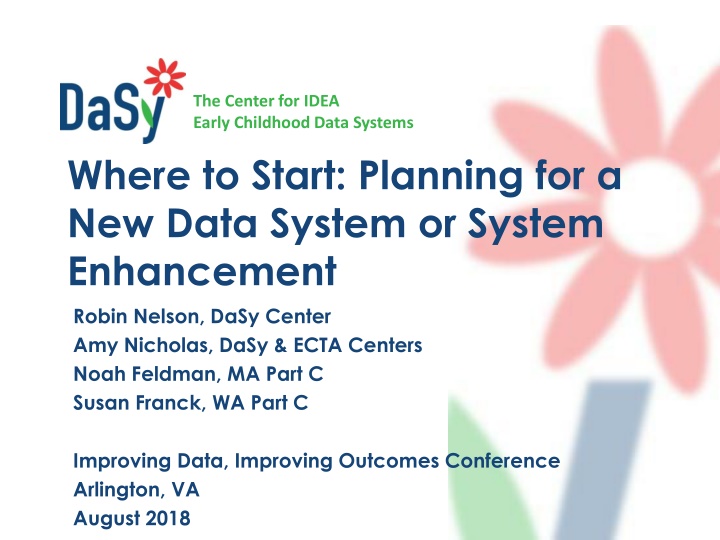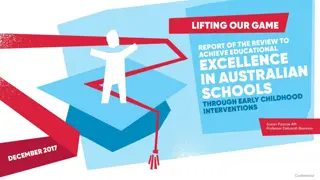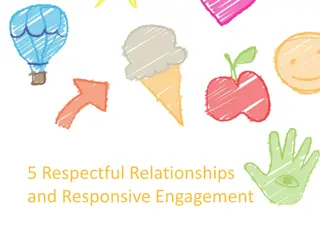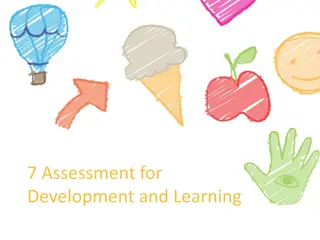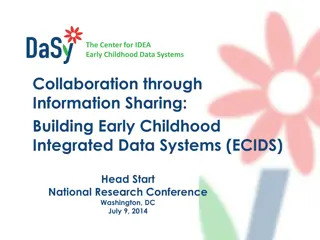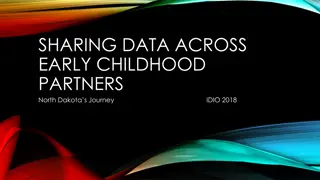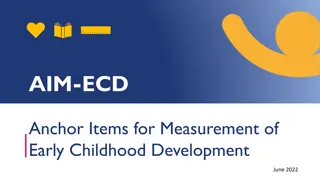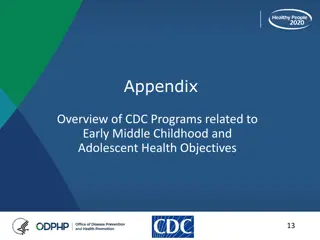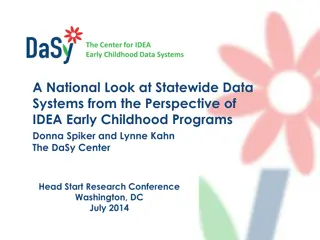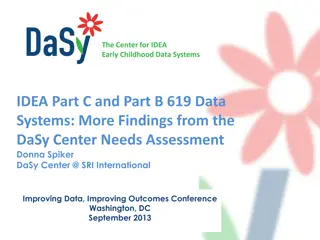Planning for Early Childhood Data System Enhancements
This session delves into key considerations for states in developing or enhancing early childhood data systems, focusing on improving IFSP and IEP processes, data entry workflows, and communication strategies. It also addresses barriers, system life cycle phases, and team formation.
Download Presentation

Please find below an Image/Link to download the presentation.
The content on the website is provided AS IS for your information and personal use only. It may not be sold, licensed, or shared on other websites without obtaining consent from the author.If you encounter any issues during the download, it is possible that the publisher has removed the file from their server.
You are allowed to download the files provided on this website for personal or commercial use, subject to the condition that they are used lawfully. All files are the property of their respective owners.
The content on the website is provided AS IS for your information and personal use only. It may not be sold, licensed, or shared on other websites without obtaining consent from the author.
E N D
Presentation Transcript
The Center for IDEA Early Childhood Data Systems Where to Start: Planning for a New Data System or System Enhancement Robin Nelson, DaSy Center Amy Nicholas, DaSy & ECTA Centers Noah Feldman, MA Part C Susan Franck, WA Part C Improving Data, Improving Outcomes Conference Arlington, VA August 2018
Session Overview This session is intended to identify key considerations for states before working through the action phases of developing or enhancing a Part C or Part B 619 data system. We will describe data system features that states are using to improve the IFSP and IEP processes, facilitate date entry/workflow, and strengthen communication and collaboration. State presenters will share experiences and learnings from managing their data system development projects. 2
Typical Barriers and Pitfalls Lack of shared vision Needs of stakeholders not aligned with vision and scope Insufficient project/contract management Taking shortcuts in development and deployment processes Architecture unsuitable for scale/scope/context 3
Phases of System Development Life Cycle 4
Where Are You? Early stages of considering something Planning new system Developing new system Planning enhancement Developing enhancement 5
Key Considerations for Initiating and Planning a New Data System or Major Data System Enhancement Available as standard pdf and fillable worksheet 6
Big Picture Issues Outcomes Scope Vision Identify and engage stakeholders Develop strategies Communication Development Implementation Risk Management of 7
Form Your Team Development Management Governance Deployment Operations 8
Project Team Project Sponsor Project Manager Developer / DBA Business Analyst Data Manager Others??? 9
Find the Right Solution In-house Procurement Options for Internal agency External agency Contract Competitive RFP Sole source Off-the-shelf Custom build Development Hosting Operations Maintenance 10
Financial Considerations Potential development costs Potential budget allocation Potential funding sources Long-term costs: support, maintenance Potential cost savings 11
Software Development Approaches Waterfall Conception Agile Conception Initiation Initiation Analysis Analysis Design Design Build Build Testing Testing Deployment Deployment 12
State Experiences with Data System Projects 13
Washington Early Supports for Infants and Toddlers (ESIT) Data management system (DMS) background Microsoft Silverlight application Databased structure was built for one workflow for service coordination Reports were built for reporting, not monitoring or measuring progress Data system enhancement project Research 14
Define what your system needs to do Describe business processes Identify and re-examine workflows Define requirements Functional/business Nonfunctional/technical IT staff turnover Implemented Agile Developed a communication plan 15
Washington ESIT DMS Current System New System Built around the Built around the child service coordinator Data collection by geographic service areas Data collection by early intervention programs System has many hard stops which disrupts work flow Limit the number of hard stops to ease work flow Add administrative functions Limited administrative functions 16
Washington ESIT DMS (cont.) Current System New System Multiple logins Single login Reports limited to reporting results Reports include monitoring progress Records actual service delivery Records planned services 17
TFS (cont.) 19
TFS (cont.) 20
Massachusetts Early Intervention Developing: New web-based client and fiscal system Full Client record EMR upload capability Full Reimbursement and payment processing Replacing: EI Information System (EIIS) and Fiscal System 20+ years old systems Access database and SQL 21
Massachusetts: CurrentEI Data Processes Local Program Data Collection Process DPH Databases: EIIS Referral Form Local Client Database EIIS Evaluation Form Human error Redundant data entry Local EIIS EIIS IFSP Form EIIS Multiple steps for data transmission Local Billing System EIIS Discharge Form Manual Data Verification TVP Website Waiver (Request for Reimbursement Separate databases that are not connected Client Record, Progress notes, IFSP Waiver Database TSS Additional processes for data needs DPH Claims System Certification Tracking Form Email form Payor System Personnel Database Claim Support documentation Email documents Third Party Payor 22 Source: DPH EI Analysis & Provider Interviews
Massachusetts: Future EI Data Processes DPH Databases: Local Program Data Collection Process Option 1 Enrollment Data Clinical Data DPH Client System EI Personnel Data Local Billing System DPH Claims System Payor System Third Party Payor 23
Massachusetts: EMR Integration Becoming Reality New EIIS as primary software EI DPH will develop extract for EMR upload 50% of EI agencies currently own EMR EMR as primary software (EIIS secondary) EI DPH will develop integration function for upload to EIIS EI agencies will develop extract for EIIS upload 24
Massachusetts: Future EI Data Processes DPH Databases: Local Program Data Collection Process Enrollment Data Option 2 Local Client Database (EMR) Clinical Data DPH Client System EI Personnel Data Local Billing System DPH Claims System Payor System Third Party Payor 25
Deciding on Features States can benefit from exploring features other states are using to collect and facilitate the reporting and use of data, including IFSP and IEP data. For each feature, specific business requirements are needed to communicate and document (in writing) all potential uses to meet program needs. Developing and Sharing Your Business Requirements to Build a Better Data System 27
DaSy Center Toolkit Including IFSP Information in Your Part C Data System: Selected Features and Related Functionality 28
What Youll Find for Each Feature Connections to the DaSy Data System Framework; Potential data elements needed to develop various aspects of the feature; A list of functionality options that could be used to implement the feature; Key design considerations; State examples,* and Related technical assistance resources. 29
We Want to Hear from You Have you used the DaSy IFSP Toolkit? If so, please share how/why. What other features would you like to see in the IFSP Toolkit? Describe any interesting things you re done or are planning to with your data system, e.g., a new feature or functionality. 31
Related DaSy Resources Key Considerations for Initiating and Planning a New Data System or Major Data System Enhancement Standard PDF and fillable worksheet IFSP Toolkit - Including IFSP Information in Your Part C Data System DaSy Framework: System Design Developing and Sharing Your Business Requirements to Build a Better Data System Building a Better Data System: What are Process and Data Models? 32
Find Us Online Visit the DaSy website at: http://dasycenter.org/ Like us on Facebook: https://www.facebook.com/dasycenter Follow us on Twitter: @DaSyCenter 33
Thank You The contents of this presentation were developed under a grant from the U.S. Department of Education, # H373Z120002. However, those contents do not necessarily represent the policy of the U.S. Department of Education, and you should not assume endorsement by the Federal Government. Project Officers, Meredith Miceli and Richelle Davis. 34
